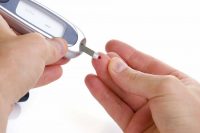
Patients with diabetes and suffering from acute kidney injury (AKI), proteinuria and uncontrolled blood sugar experience a sharp reduction in the number of years they have healthy renal function before being forced onto dialysis, according to researchers at the University of Cincinnati (UC) College of Medicine.
The UC research team looked at 3,679 individuals with Type 2 diabetes from a de-identified cohort of patients at the Cincinnati Veterans Affairs Medical Center and who were followed for a 10-year period, explains Charuhas Thakar, MD, professor and director of the UC Division of Nephrology, Kidney CARE Program.
The three risk factors — AKI, proteinuria (leakage of protein into the urine) and poor blood sugar control — were used to classify patients into three groups, he says. Patients with diabetes who had none of these risk factors were compared against a group that had all three risk factors (severe risk) and another group that had only one or two of the risk factors (medium risk).
“There are established risk factors in the diabetes literature,” says Thakar. “One of them is the level of sugar control; if you don’t control your sugar well your kidney disease progresses faster or if you leak protein in the urine and you have proteinuria, it tends to be an independent predictor of kidney disease in diabetics.”
Typically, a 50-year-old person with Type 2 diabetes without any of the risk factors has kidney function of about 60 percent and is likely to lose renal function at around 1.9 to 2 percent annually, says Thakar. That means this individual would have 25 to 30 years before kidney failure forces the need for dialysis allowing the patient to have normal renal function up to age 80.
But if the same individual with diabetes suffered from all three risk factors the loss of renal function would accelerate to nearly 5 percent annually, says Thakar. This means the patient would need dialysis within 12 years at age 62. For a patient with two of the three risk factors, there is still a medium risk of accelerated loss of renal function, he explains.
“This is a big impact for a patient,” says Thakar, who is corresponding author for the research. “You are talking about pruning 18 to 20 years off of when you will have to go on dialysis. It’s very important information for a patient and clinician to know. The study is among the first to examine the interrelationship between these traditional risk factors for its effect on kidney disease progression.”
The research was presented orally and as a poster at the American Society of Nephrology Kidney Week, on November 19, 2016, in Chicago, by Mollie Sands, a fourth-year medical student in the UC College of Medicine. She is first author of the research, while Anthony Leonard, PhD, UC assistant professor of family medicine, is also a co-author.
Thakar says 29 million Americans have diabetes and one in three will have chronic kidney disease. He says patients with diabetes and chronic kidney disease are among the most vulnerable to sustain acute kidney injury when hospitalized.
Physicians need to consider looking at patients with diabetes who have different risk factors separately and design tailored strategies to both monitor and treat them, says Thakar.
“We have the same tools in our arsenal to help these patients in terms of their progression of kidney disease; so our research raises questions and challenges the field of physicians,” says Thakar. “We should find ways to monitor these three groups of patients differently and target our therapies. Future studies need to evaluate how we are going to change the trajectory of loss of renal function in these patients who may suffer a faster decline by either modifying existing treatment or discovering new therapies.”







Leave a Reply
You must be logged in to post a comment.